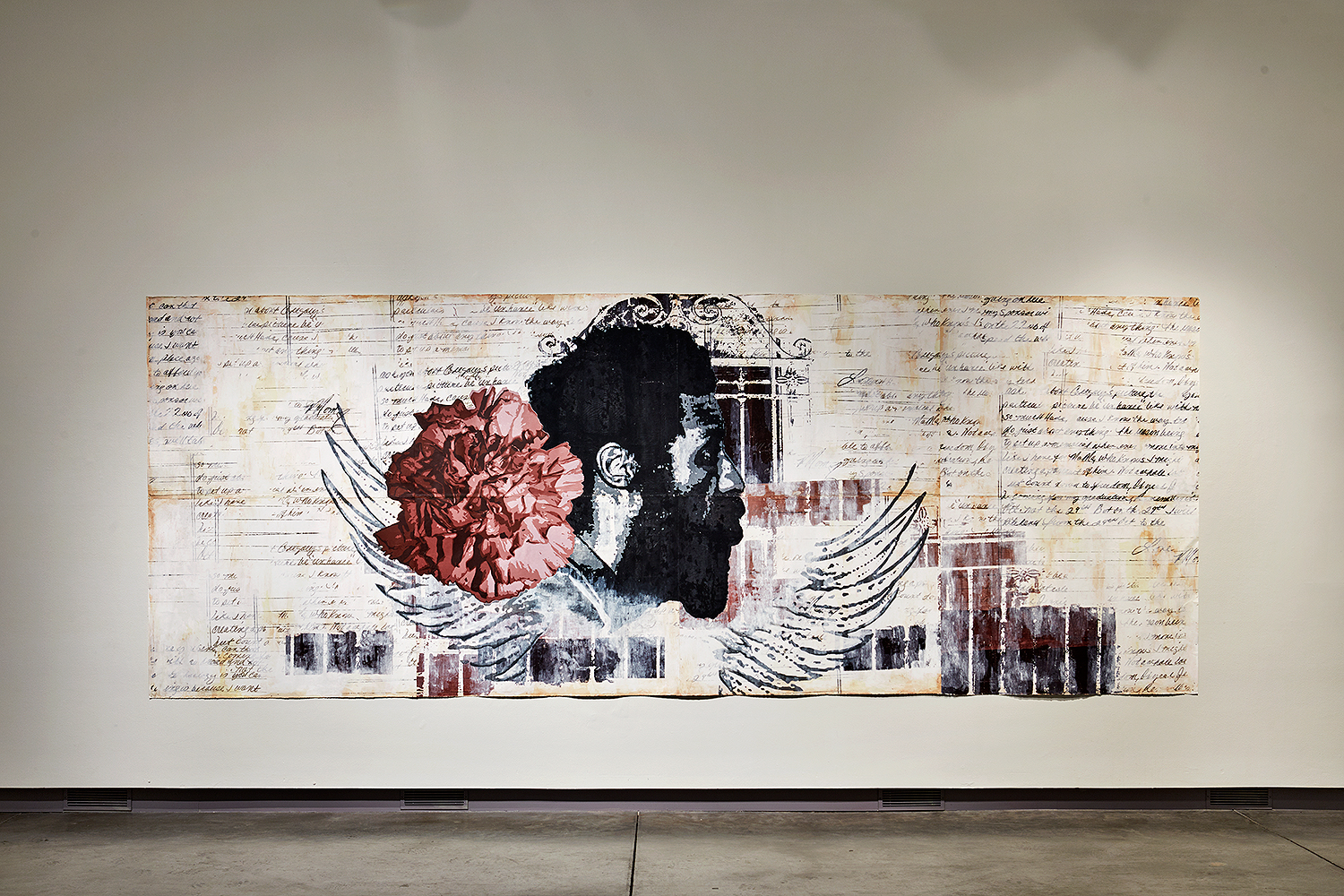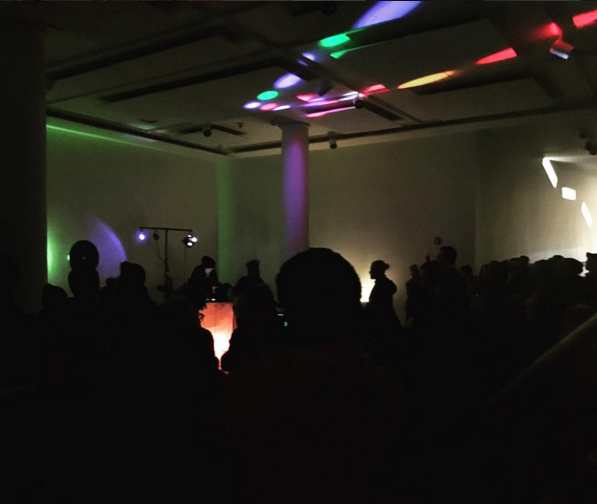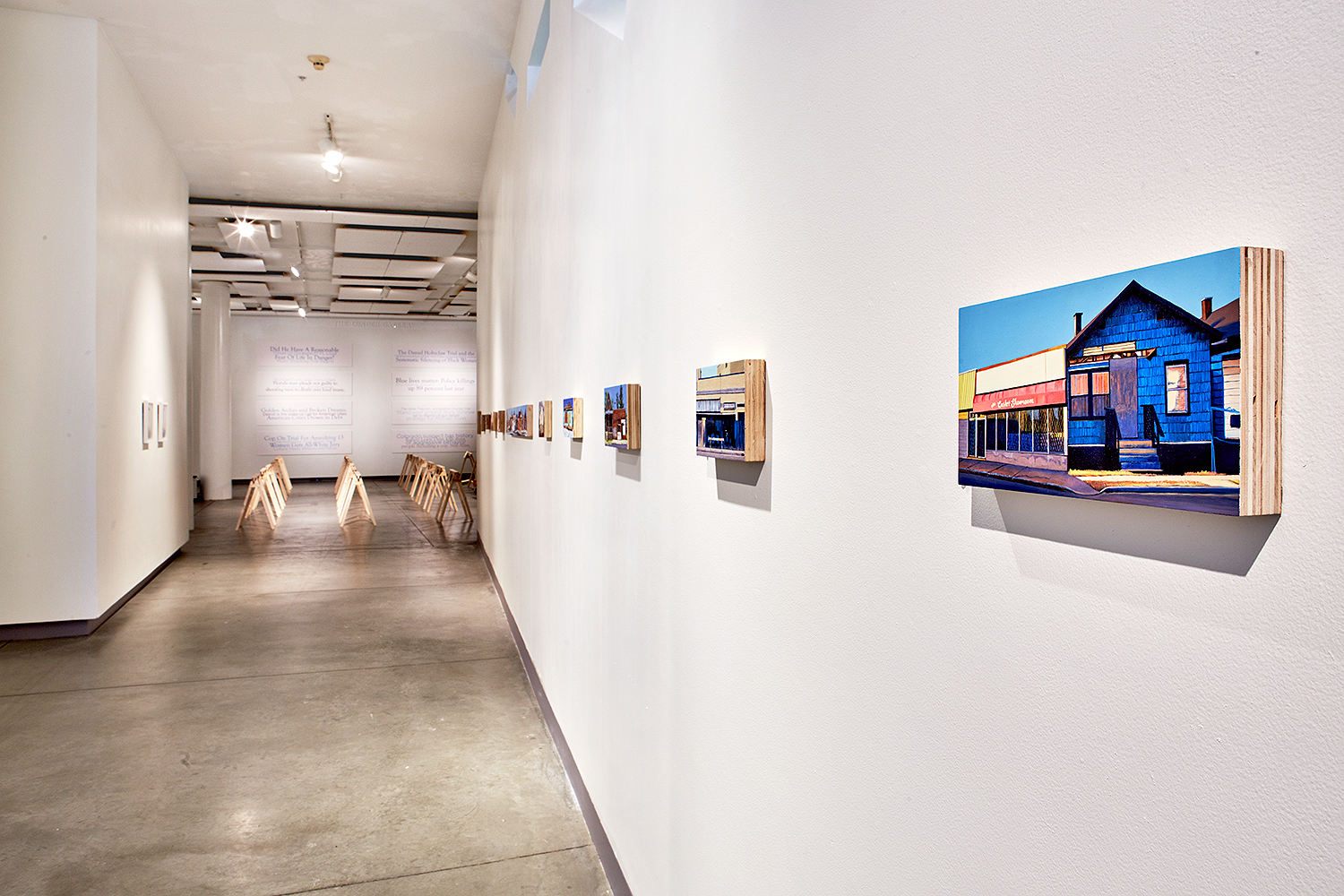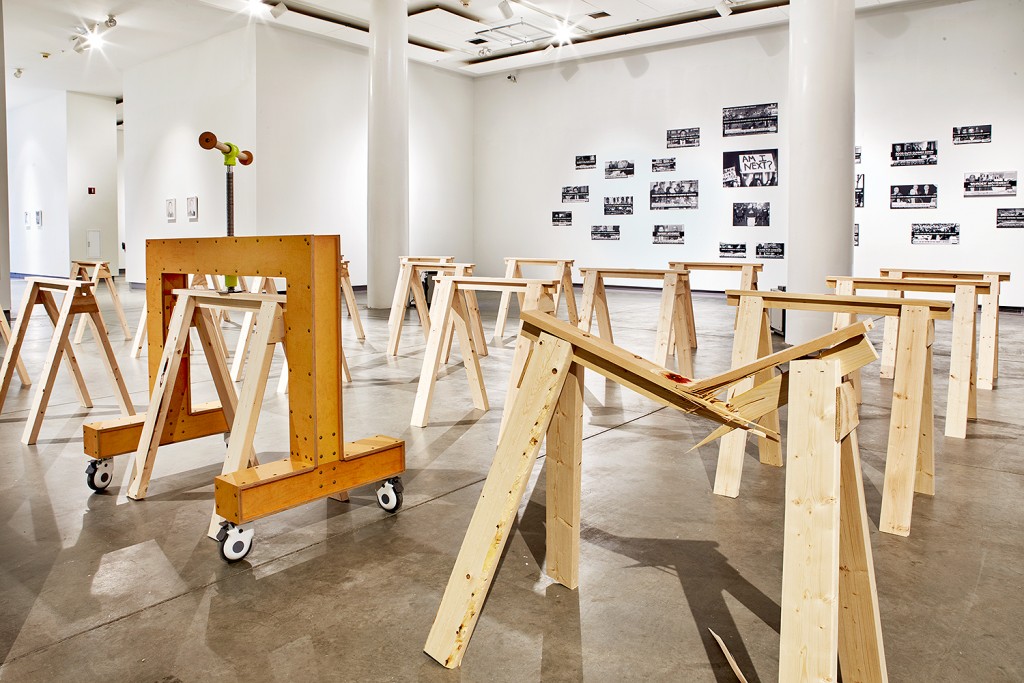The term tinderbox refers to “a thing that is readily ignited”. It houses all of the kindling one will need to start a raging blaze. In America, we are currently standing on a tinderbox: the Flint Water Crisis; the shooting death of Tamir Rice and ultimate dismissal of his murderers; Donald Trump’s most recent inflammatory comment at a rally at the Sioux Center in Iowa, stating that he “could stand in the middle of 5th Avenue and shoot somebody and…wouldn’t lose voters.”1 All of these instances, and more, have been adding to the kindling and leading to a monster of a blaze.
The term tinderbox is also the first show of 2016 at the The Institute of Contemporary Art at Maine College of Art, and it is a fitting one. The five artists included in the show are Trina May Smith, Tyanna Buie, Martine Kaczynski, Adam Manley, and Hi Tiger.
I sat down with the curator, Kyle Patnaude — who is also an artist and educator — to ask him a few questions regarding the role of curation in activism, art as change, agitating, and “checking your privilege”.
Veronica A. Perez: Did you have an idea in mind for what you wanted when you were approached to curate a show at the ICA? What was your impetus for selecting the artists? And how did the name tinderbox come to encompass the show?
KP: In the curatorial sense, I started with the theme first, thinking through the possibilities of what a subject like this could do as an exhibition and what the artists could do through the contexts of their work. I tend to also work like this in my own practice as an artist: I present something that’s a hot button issue, but present it with a cool tone. Shouting makes people shut off, especially with extremely contentious issues, but the way these works discuss this subject is with a very cool, low guttural tone, very subversive.
This show also stemmed from living here in Portland, Maine, and moving from from Madison, Wisconsin — [there’s] a largely white populace in both places, and both, for me, have interesting social aspects. Wisconsin is the state that unionization and the birth of the labor movement generated from, and within Maine, there is an abundance of blue collar workers, but they are not necessarily putting themselves in the greater conversation.
Additionally, I love to check people on their privilege, meaning, how and where they position themselves in culture and society. This comes from me being a person situated as an “other”: a gay man, but also with white male privilege. I needed to showcase other aspects of culture and bring these into a larger dialogue. I wanted to showcase the voices of the artists who are working within these issues and from there, engage with an audience that can then check themselves. The show is not purely voyeuristic: it becomes something you are engaged in a dialogue with. This show is not fleeting, it’s culturally and socially relevant.

VAP: What is the difference between a visceral and an intellectual experience? In tinderbox I see both.
KP: If you want to have a real intellectual conversation it has to be a visceral experience. You exist as body and mind; you understand things by engaging with them on a physical level as well as mental level. It’s one thing to watch a protest on TV and another actually being on the streets of Ferguson. If you don’t have that awareness to equate to, it is difficult to fully understand. In order to explain something you have to engage with it on a visceral level to get it on an intellectual level. I see that the most in Adam Manley’s work.
VAP: How can artists add to the conversation and become a catalyst for change in today’s society? How does the role of curation play a part in starting these difficult conversations?
KP: I don’t know if artists can be the sole catalyst for change. Curatorially, agency comes in to making this space something different than showing pieces on the wall. There was a performance on the opening night by Hi Tiger, a queer punk performance group. Hi Tiger is high energy but that energy is channeled; they are a fierce force. There is definitely anger in their performances, but not anger for anger’s sake — it transcends into a fabulous punk mentality. Hi Tiger are agitators and teach us how to be rock and roll, glam, and to be influential. They alone are not going to make change, but they can try to change the way you think.

In their [opening night] performance, frontman Derek Jackson played a character, the butch black male in a knitted hat and baggy pants. He was playing to the part: the role and mask that is one side a threat from the default white perspective, and an internalized racism. Derek told me that if he saw himself in this role, he, as a queer man, would cross the street because he’d be afraid of getting bashed. In telling these stories, they can add to the dialogue and find a few allies along the way.
This brings me back to the role of curator. I think what has changed is that we are seeing more of the “artist-curator” at places which are safe to do this type of curation, like the ICA. The artworks in this situation become my medium in putting together an experience and to frame or re-frame and re-contextualize either the issue at hand or sometimes the work included. We [as artists and curators] have access that other people don’t. We have this freedom to voice our opinions and histories, even more so than politicians or a newscasters. They have rules that we do not. And by working with the institutions we can get these things out. By turning things onto their heads, we begin to change the canon of art. Not only an aggregation space for people but also ideas; it’s an ignition point. I do not want to tell people what they should think, but this space gives people a chance to think things for themselves.
VAP: How do the responses to this show manifest themselves in Maine, where the population is mostly white?
KP: Visitors have had positive responses to the works, but one of the troubling questions has been “What does this have to do with Maine? Where is the Maine-ness?” This is a problem. Getting the chance to open up someone’s purview to something different from the Portland and New England area is why I decided to take on this show and the themes that followed.

VAP: Finally what do you, as curator, want viewers to take away from the show?
KP: I want viewers to take away what their expectations of what an art institution can do. To find something they can connect to, even if they leave angry. Then they will at least start talking and engaging with people. This is really is about creating a dialogue, not about changing their minds. It becomes about reading work in a different way [curatorially speaking], not blatantly putting works together, but bringing things into a heightened context. The work of tinderbox might be easily digestible on the surface, but it is also multi-faceted with deeper meaning.
I remember my protestor days back in New York during the Bush Administration: I was handing out stacks of postcards on the subway, with images of things you weren’t supposed to see, such as caskets coming back from Iraq, and I saw a Marine sitting with his two-year old daughter. He saw me handing these things out to people and as soon as he saw me, I stopped and walked right out of the train and he followed me. He stopped and asked, “Can I have a stack of those?” So I gave him the whole stack and he said, “Thank you, I appreciate this”.
So in this instance, I had to check my liberalism, my own activism. For some reason, that Marine was off limits to me, and that was absolutely the person I needed to talk to. It absolutely changed me, being in NYC and protesting. It was difficult to continue with because nothing came about, I was preaching to the choir. And this is how tinderbox manifested itself. When it becomes about people you know, in your own life, in your own community, then it is something that does work.
Patnaude’s curatorial response of tinderbox juxtaposed with society today is as visceral as it is intellectual. This is a critical time in American history and it is not the first time we find ourselves at this juncture. But, something is different here: we are seeing art and information work together like never before. We are seeing headlines in a gallery that we have just seen that very morning and did not want to deal with. But now we are forced to.
tinderbox is on view at the Institute of Contemporary Art at MECA through March 5, 2016.
Institute of Contemporary Art at Maine College of Art
522 Congress Street, Portland, ME | 207.699.5025
Open Wednesday–Sunday 11am–5pm, Thursday 11am–7pm. First Fridays 11am–8pm. Free.
Special Event: Friday, January 29, 2016
The Abyssinian Meeting House a non-for-profit organization, will gather within the Public Aggregation Space of the exhibition for a special event and discourse on Friday January 29th. Built in 1828, the Abyssinian Meeting House is a modest house of worship with great historic significance to the people in Maine. Serving as a school for African-American children, community center, and a stop on the Underground Railroad, the Abyssinian is the third oldest-standing African-American meeting house in the United States.
- http://america.aljazeera.com/articles/2016/1/24/trump-says-he-could-shoot-somebody-and-not-lose-voters1.html ↩
Veronica A. Perez was born in 1983 in New Jersey. Perez received her BFA from Moore College of Art and Design in 2014 and her MFA from Maine College of Art in 2016. Currently, she is living, working, and teaching in South Portland, Maine.
Perez works mostly in the mediums of sculpture and photography. Usually utilizing construction and kitschy materials in her pieces, Perez creates intense personal moments by means of hybridization, ideals of beauty, nostalgia, while fragility echoes sentiments of a lost self, and at the same time paralleling contemporary feminist tensions.

